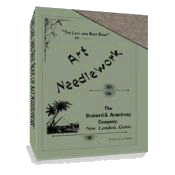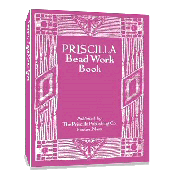Inexpensive Fancy Work
for the Holidays
1897
Inexpensive Fancy Work was written by Mary J Safford, for Harper's Bazaar's
December 1897 issue. It has been edited for use on this site.
The search for “something new under the sun” never ends. One would think that ingenuity was exhausted, but each year clever brains — often, alas! Under the scourge of necessity — devise either something completely novel or another variety of an article already in use. Women who sell their work in the Exchanges know the advantage of making these new trifles, for which there is always a demand; and for their benefit, as well as that of those who like to prepare their gifts with their own hands, the following inexpensive ones are described.
Inexpensive Fancy Work #1
Pig Pen-Wipers
A pen-wiper is certainly no novelty, but at a recent sale people were eagerly buying some in the shape of pigs, cut from pieces of flesh-colored chamois-skin, about an inch and a half long and three inches wide. The pattern could easily be obtained from some advertisement. A few strokes of the pen or brush outline in black on the animal the ears, legs, etc., giving a perfect representation of a portly porker, whose side bears the familiar legend “Extracts from the pen of,” or “Write from the pen of” — any sentence, in short, introducing the two meanings of the word. Here is a chance for the maker to display originality. “Escaped from the pen of,” followed by the name of the person who is to receive the gift, would be an excellent inscription. Cut two more pieces of the same shape, make tow little slits in the upper part of the pig’s back, pas baby-ribbon through, and tie in a bow.
Inexpensive Fancy Work #2
Pin-Cushions
Charmingly dainty cushions, either oblong for hat-pins, or the tiny square ones, are made by basting a piece of white point d’esprit upon linen, and then making a row of button-hole stitch with whatever shade of embroidery silk the cushion is to be, to fasten the point d’esprit to the linen. Mark the shape — round, oval, or oblong — and the size you wish the point d’esprit to be before commencing. An inch and a half will be quite large enough for the square ones. For the latter, work at each corner, on the linen, a tiny spray of green leaves and a flower of the color chosen. If the point d’esprit is to be oval or oblong, two more sprays will be needed at the sides. When the embroidery is finished, cut away the lines under the point d’esprit and place the cover over the cushion. Finish the square one with narrow hem and frill of lace, and arrange on the cushion to a diamond, putting bows of inch-wide ribbon on the corners.
For an oblong one — turn the linen in and sew on half-way down the sides and ends of the cushion, covering with a ruffle of pink sink, over which lace of the same width is gathered, finished with clusters of baby-ribbon at the corners. The color of the cushion should be a little deeper than the embroidery, to give the right effect when seen through the point d’esprit. Rose-buds with a pink cushion, tiny carnation pinks on a red one, buttercups on a yellow one, and ferns on a green are equally attractive.
Inexpensive Fancy Work #3
Match Scratchers
A new variety of this useful article is made of a piece of water-color paper seven inches long and four inches wide, on which was the figure of a man with his back turned. The coat was made of sand-paper glued to the foundation: the rest was painted. At the top was “Scratch My Back.” A loop of ribbon, the ends concealed under bows, passed from corner to corner.
Inexpensive Fancy Work #4
Calendar
A calendar which drew both attention and purchasers at a recent sale was made of heavy water-color paper eight inches long and ten inches wide. The irregular edge was finished with a line of color matching the ribbon fastened at the upper corners to form a loop.
At the bottom a five-barred gate was painted, with some grasses and field flowers below. At the lower right-hand corner was fastened a calendar, and on the gate were three figures about three inches long, dressed in paper in Japanese costume, one on the top bar, the other two on the middle one. The space between the gate and the top of the card was occupied by the following lines, done in fancy lettering:
Three little heathen
Sitting on a gate,
But every one
Is up to date.
Inexpensive Fancy Work #5
Memorandum Pads
The ordinary five-cent memorandum pads are transformed into dainty gifts by being slipped into covers, some of which can have sprays of forget-me-nots painted diagonally across the right-hand lower corner, while the upper left-hand corner bears the words “For-get-me-not.” A pencil tied with blue baby ribbon matches the flowers. Others, without lettering, have a bunch of holly, and the pencil hung by a scarlet ribbon.
Inexpensive Fancy Work #6
Wash-Cloth Cases
Simple wash-cloth cases are made of a bit of plaid toweling nine inches long and five inches wide. The corners of one end are rounded off the center, commencing an inch on the sides. A piece of white rubber-cloth the same shape and size is laid on the towelling, and the straight ends of both are bound together with narrow white linen braid, the turned up to the depth of three inches and a half, and beginning at the bottom of the pocket, the braid is stitched on up the sides, around the curved end, and down to the bottom of the other side. A button-hole is worked in the center of the flap, half an inch from the edge, and a pearl button sewed on the pocket under it. Inside the case is a neatly folded wash-cloth made of a piece of Turkish towelling ten inches square, hemmed around.
If intended for a gift, this case could be made of plain white linen duck, with initials embroidered on the flap with white linen thread, and row of feather-stitching above the braid binding.
Return to top of Inexpensive Fancy Work for the Holidays – 1897 page.
Return to Victorian Christmas page.
The Last and Best Book of Art Needlework
Over 100 pages of authentic Victorian instructions and patterns from 1895!
FREE
Beeton's Book Of Needlework

433 pages!
Sign up for VEAC! Everything you wanted to know about Victorian embroidery, needlework, crafts and more!
Priscilla Bead Work Book
Make Beautiful Victorian Beaded Purses, Jewelry & Accessories - Starting
TODAY!



